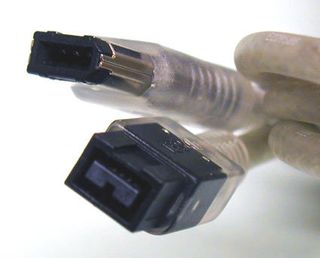Go External: FireWire 800
FireWire - The Story So Far
FireWire was first established as the IEEE 1394 standard in 1995. With a rate of up to 400 Mbps, this port (also known as i.LINK from Sony or Lynx from TI) was far superior to any other available protocol at the time. It also offered the ability of setting up and interrupting the connection while operation was in progress ('hot plugging').
The 1394 standard is a bus protocol, which can accommodate up to 63 devices. Unlike BNC networks or SCSI, these devices do not have to be physically connected in series, but can also be arranged in branches. Moreover, a signaling cable does not have to be terminated with a resistor, and device addresses are assigned dynamically in the background.
In recent years, FireWire has also become a standard feature for high-end motherboards. Texas Instruments, VIA and others all now offer corresponding, highly affordable FireWire controller chips.
Moreover, despite a theoretical lower data transfer speed compared to USB 2.0, IEEE1394 consistently offers slightly faster transfer speeds in practice, and the CPU load is lower with high quality FireWire chips.
Technical Basis To FireWire

This cable is also used for operating an older FireWire device connected to a 1394b controller.
The interface is based on a six pin connector, which uses two twisted pairs of wires for data communication and two wires for the power supply. This setup permits between 8 V and 30 V with up to 1.5 A.
The maximum cable length from device to device is max. 4.5 m at full power. At the same time, however, it only is possible to connect a maximum of 17 devices directly in series. Closed circuits are not allowed, either. In practice, however, configurations of 1 to 3 devices are normally found.
Stay on the Cutting Edge
Join the experts who read Tom's Hardware for the inside track on enthusiast PC tech news — and have for over 25 years. We'll send breaking news and in-depth reviews of CPUs, GPUs, AI, maker hardware and more straight to your inbox.
A further advantage of FireWire over USB 2.0 also should not be underestimated: Compared to USB 2.0, FireWire devices will generally also run without difficulties under Linux and Mac OS'.
Current page: FireWire - The Story So Far
Prev Page FireWire's High Speed Data Transfer Potential Next Page FireWire's i.Link For NotebooksMost Popular

